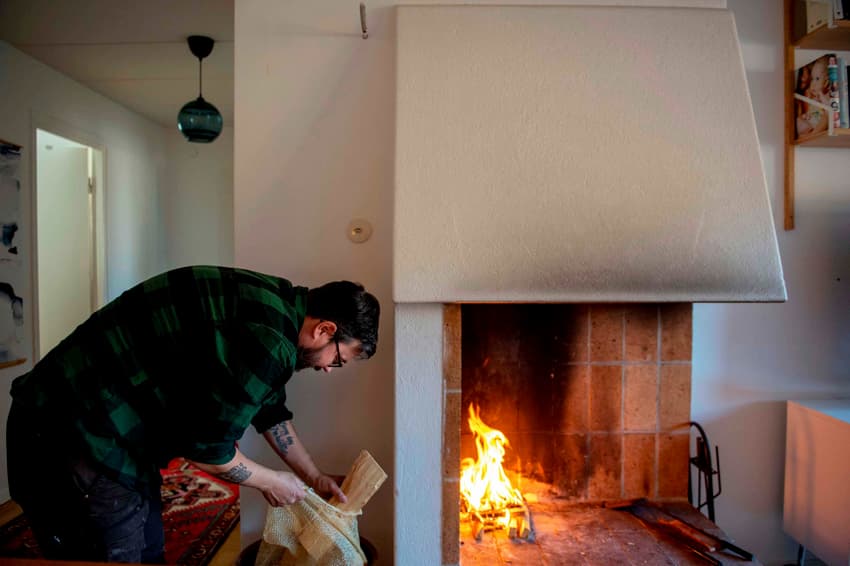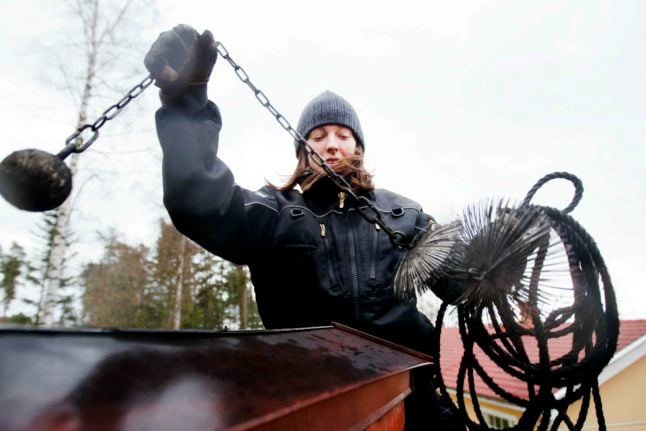What rules are there for wood burners and fireplaces in Sweden?

The colder weather is drawing in, and many people in Sweden will soon be firing up wood burners and fireplaces to help heat their homes during the winter. What rules do you have to bear in mind?
What fuel can I use?
As a general rule, you should only burn dry wood. Guidelines from the Swedish Environmental Protection Agency state that your wood must have dried for at least 6 months, in a covered outdoor location.
Once you've brought it inside, try to use it within two weeks - otherwise it can dry out too much, meaning it burns more quickly, produces less heat and more soot.
On the other hand, if your wood is too wet, this can also cause issues. It will produce a lot of smoke, will not burn well and will emit a larger amount of environmentally hazardous substances.
It is illegal to burn rubbish such as milk cartons or plastic, as well as impregnated or painted wood, chipboard and plywood.
Coal is rarely used for heating private homes in Sweden due to the environmental impact, although there are no official bans on burning coal in indoor fireplaces.
Keep in mind that many modern fireplaces or wood burners are not designed for burning coal, and older fireplaces may only be approved for burning wood, so make sure you check the recommendations for your heater if you plan on using coal.
On the topic of older fireplaces, make sure you check with your council or building owner whether you are permitted to use your fireplace before you light a fire. If it hasn't been used for a number of years, you may need to schedule an inspection, where an expert will inspect your fireplace and chimney for any cracks or areas that need repairing.
When can I light a fire?
Depending on where you live, there may be rules on when you are allowed to light a fire if it is not your primary source of heating. This is usually referred to as trivseleldning - lighting a fire for cosiness or comfort, rather than necessity.
In Malmö, for example, you are only allowed to light fires in tiled chimneys (kakelugnar), open fireplaces or woodburners between October 1st and March 31st. Some municipalities - Malmö included - also recommend lighting a fire no more than twice a week, for a maximum of four hours at a time.
Anna Nordkvist, a chimneysweep in Västerås, prepares to swing a chimney brush into a chimney. Photo: Per Groth/TT/Scanpix
Stockholm and Gothenburg have no rules on what time of year you are allowed to light a fire, or how often, but all three city councils underline the importance of considering your neighbours and only lighting a fire on days where it is windy enough for the smoke produced to be sufficiently dispersed.
If you live in another area, try searching for elda inomhus, plus the name of your local municipality, to find out the rules where you live.
If you burn wood in a way that causes irritation to your neighbours, they have the right to complain to the local council's environmental department, who have the power to issue you with a ban on using your fireplace.
How often should I clean my chimney?
Depending on whether you live in a house or apartment, you may be responsible for organising chimney-sweeping yourself, or this might be the responsibility of the owner of your building.
Usually, if your fireplace or wood burner is not your primary source of heating and you only use it occasionally, your chimney won't need to be swept more than once every three years.
If you're not sure when your chimney was last swept (either because you don't use it very often or because you recently moved into your property), try contacting your local council or searching for sotare (chimney sweep) or sotning (chimney-sweeping), plus the area where you live for advice. Most councils have a list over the properties in their area with chimneys and when they were last cleaned, or they will refer you to their approved contractors who should be able to help you.
Comments
See Also
What fuel can I use?
As a general rule, you should only burn dry wood. Guidelines from the Swedish Environmental Protection Agency state that your wood must have dried for at least 6 months, in a covered outdoor location.
Once you've brought it inside, try to use it within two weeks - otherwise it can dry out too much, meaning it burns more quickly, produces less heat and more soot.
On the other hand, if your wood is too wet, this can also cause issues. It will produce a lot of smoke, will not burn well and will emit a larger amount of environmentally hazardous substances.
It is illegal to burn rubbish such as milk cartons or plastic, as well as impregnated or painted wood, chipboard and plywood.
Coal is rarely used for heating private homes in Sweden due to the environmental impact, although there are no official bans on burning coal in indoor fireplaces.
Keep in mind that many modern fireplaces or wood burners are not designed for burning coal, and older fireplaces may only be approved for burning wood, so make sure you check the recommendations for your heater if you plan on using coal.
On the topic of older fireplaces, make sure you check with your council or building owner whether you are permitted to use your fireplace before you light a fire. If it hasn't been used for a number of years, you may need to schedule an inspection, where an expert will inspect your fireplace and chimney for any cracks or areas that need repairing.
When can I light a fire?
Depending on where you live, there may be rules on when you are allowed to light a fire if it is not your primary source of heating. This is usually referred to as trivseleldning - lighting a fire for cosiness or comfort, rather than necessity.
In Malmö, for example, you are only allowed to light fires in tiled chimneys (kakelugnar), open fireplaces or woodburners between October 1st and March 31st. Some municipalities - Malmö included - also recommend lighting a fire no more than twice a week, for a maximum of four hours at a time.
Stockholm and Gothenburg have no rules on what time of year you are allowed to light a fire, or how often, but all three city councils underline the importance of considering your neighbours and only lighting a fire on days where it is windy enough for the smoke produced to be sufficiently dispersed.
If you live in another area, try searching for elda inomhus, plus the name of your local municipality, to find out the rules where you live.
If you burn wood in a way that causes irritation to your neighbours, they have the right to complain to the local council's environmental department, who have the power to issue you with a ban on using your fireplace.
How often should I clean my chimney?
Depending on whether you live in a house or apartment, you may be responsible for organising chimney-sweeping yourself, or this might be the responsibility of the owner of your building.
Usually, if your fireplace or wood burner is not your primary source of heating and you only use it occasionally, your chimney won't need to be swept more than once every three years.
If you're not sure when your chimney was last swept (either because you don't use it very often or because you recently moved into your property), try contacting your local council or searching for sotare (chimney sweep) or sotning (chimney-sweeping), plus the area where you live for advice. Most councils have a list over the properties in their area with chimneys and when they were last cleaned, or they will refer you to their approved contractors who should be able to help you.

Join the conversation in our comments section below. Share your own views and experience and if you have a question or suggestion for our journalists then email us at [email protected].
Please keep comments civil, constructive and on topic – and make sure to read our terms of use before getting involved.
Please log in here to leave a comment.